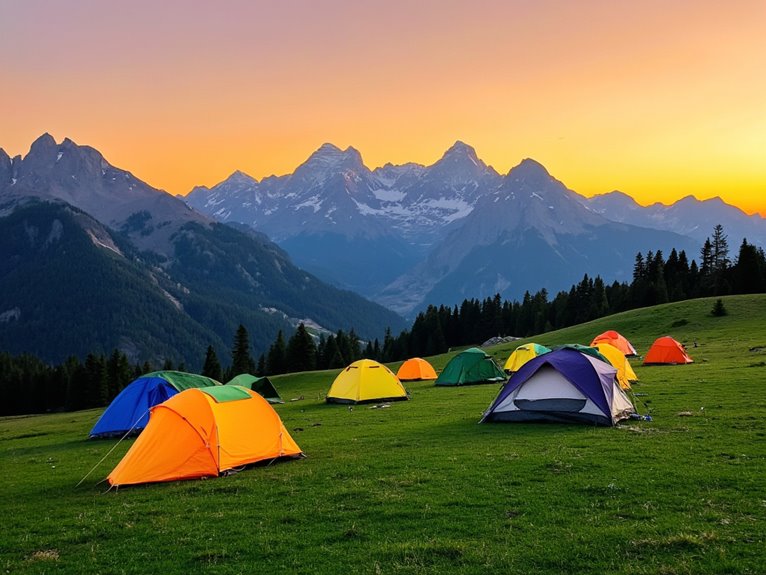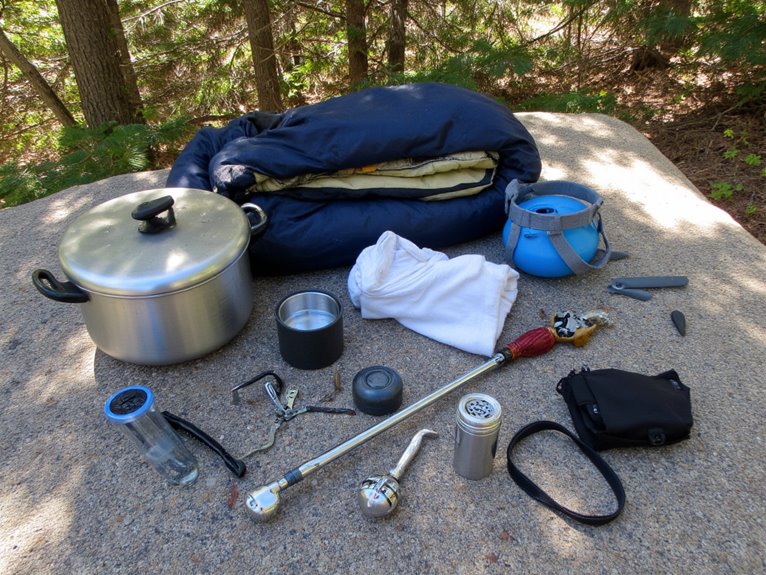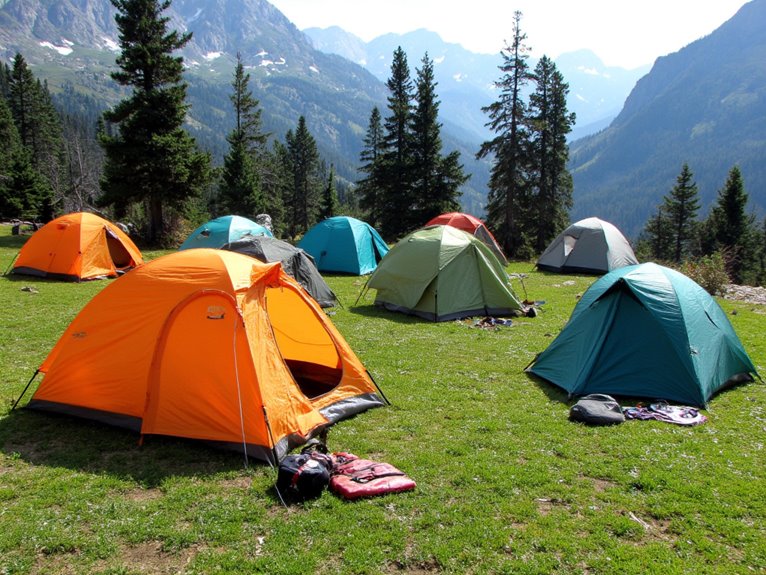10 Best Value Backpacking Tents That Won’t Break the Bank
After testing dozens of budget tents under $150, I’ve identified ten standout models that deliver essential backpacking performance without premium prices. The MC TOMOUNT and GEERTOP Ultralight lead my list, both weighing around 4.6 pounds with 3000mm waterproof ratings and sub-10-minute setup times. The Clostnature Polaris offers superior 5000mm protection at 4.52 pounds, while the Night Cat provides ultra-quick one-minute assembly. Each tent balances weight, weather resistance, and affordability effectively for serious outdoor enthusiasts seeking reliable shelter options.
We are supported by our audience. When you purchase through links on our site, we may earn an affiliate commission, at no extra cost for you. Learn more. Last update on 18th December 2025 / Images from Amazon Product Advertising API.
Notable Insights
- Look for tents weighing 4-5 pounds with waterproof ratings of 3000mm+ for optimal backpacking performance and weather protection.
- Quick setup times under 10 minutes are essential, with some models like Night Cat offering 1-minute assembly.
- Consider freestanding designs with dual vestibules for gear storage, like the Clostnature Polaris with superior PU5000mm waterproofing.
- Target packed sizes around 16-17 inches to fit standard backpacks while maintaining spacious interiors for comfort.
- Budget-friendly options like BISINNA and MC TOMOUNT offer 4.6-star ratings with reliable three-season performance under $100.
MC TOMOUNT Backpacking Tent 1-2 Person Waterproof Lightweight for Outdoor Camping
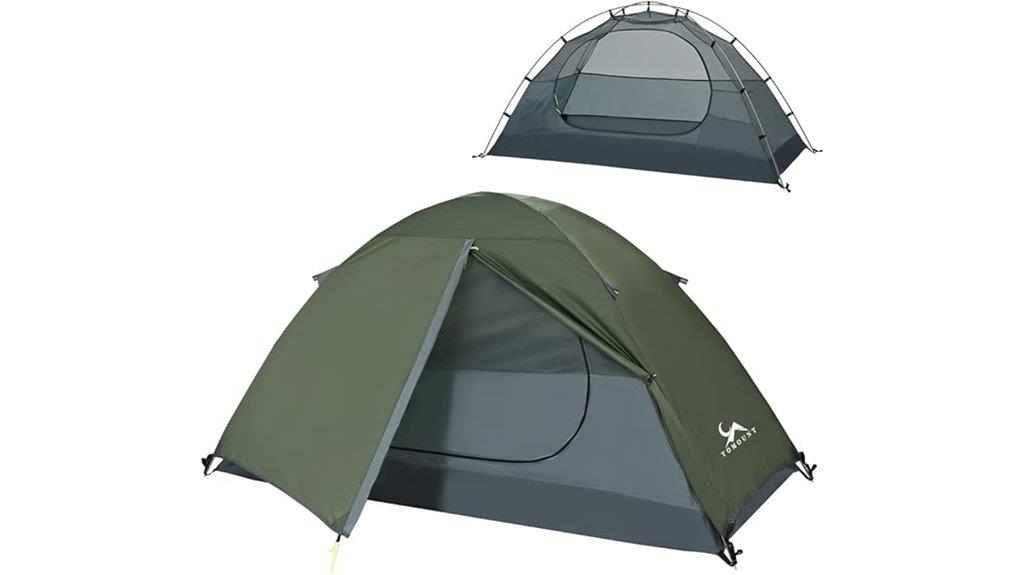
The MC TOMOUNT Backpacking Tent delivers exceptional value for budget-conscious hikers and casual campers who need reliable shelter without premium pricing. You’ll get a 4.65-pound tent that handles two people comfortably within dimensions of 13.4 x 31.5 x 13.4 inches. The construction uses aluminum poles with 210D Oxford fabric flooring and 210T rip-stop polyester walls rated PU3000m waterproof. Setup takes 10-15 minutes using the straightforward design. You’ll appreciate the double-layer construction with mesh inner net for ventilation control. The tent’s earned 4.6 stars from 351 reviews, proving its reliability in storms while maintaining breathability that prevents condensation buildup.
Best For: Budget-conscious hikers and casual campers who need reliable, lightweight shelter for 1-2 people with quick setup and proven waterproof performance.
Pros:
- Excellent waterproof rating (PU3000m) with double-layer construction and mesh ventilation that prevents condensation buildup
- Quick 10-15 minute setup process that’s user-friendly for beginners and experienced campers alike
- Outstanding value with 4.6-star rating from 351 reviews proving durability in stormy conditions at an affordable price point
Cons:
- Thin tent floor requires additional ground sheet for optimal protection and durability
- Basic tent pegs may need upgrading for more secure anchoring in challenging conditions
- Limited storage space and weight capacity may be restrictive for larger users or extended trips
GEERTOP Ultralight 2 Person Waterproof Camping Tent
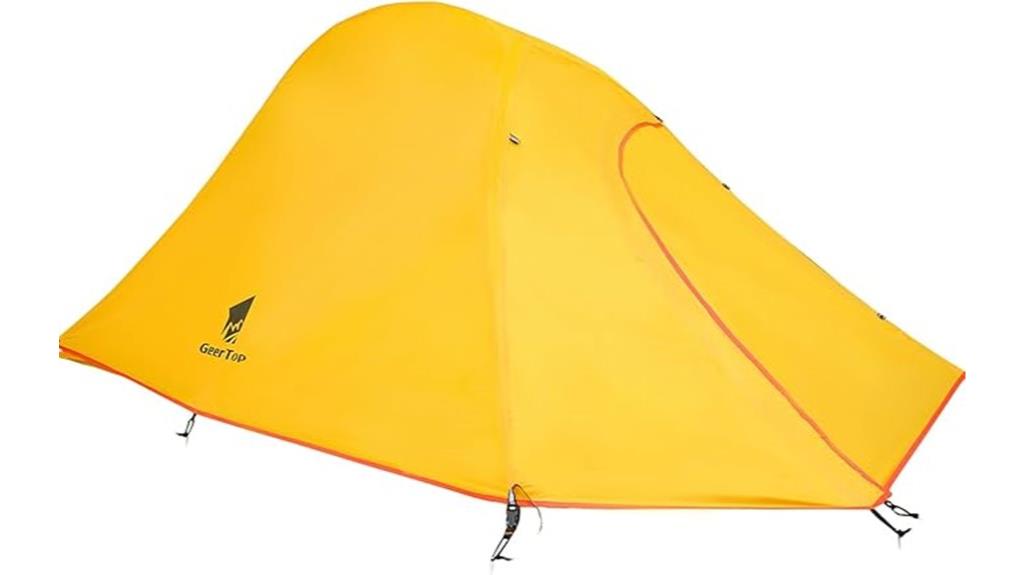
GEERTOP’s Ultralight 2 Person Waterproof Camping Tent delivers exceptional value for backpackers who prioritize quick setup without sacrificing weather protection. You’ll assemble this tent in under two minutes using pre-attached Y-frame aluminum poles. The freestanding design requires only rear corner staking for stability.
At 4.6 pounds, you’re getting serious weather protection. The PU3000mm waterproof polyester withstands heavy rain, while 7001 aircraft-grade aluminum poles resist winds exceeding 35 mph. Taped seams prevent water infiltration during storms.
The 82.6 x 49.2-inch interior provides adequate space for two campers, though it’ll feel tight. You’ll appreciate the 43-inch peak height for comfortable sitting. The oversized vestibule stores gear securely. High-density B3 mesh ventilation reduces condensation effectively.
Best For: Backpackers and campers who need quick-setup weather protection for short trips and don’t mind slightly cramped quarters when sharing the tent.
Pros:
- Incredibly fast 2-minute setup with pre-attached poles and freestanding design
- Excellent weather protection with PU3000mm waterproofing and wind resistance up to 35+ mph
- Lightweight at 4.6 lbs with spacious vestibule for gear storage
Cons:
- Interior feels tight and cramped when used by two people
- Better suited for short trips rather than extended camping adventures
- Requires rear corner staking for proper stability despite freestanding design
Clostnature Polaris Lightweight Backpacking Tent for Outdoor, Hiking and Mountaineering
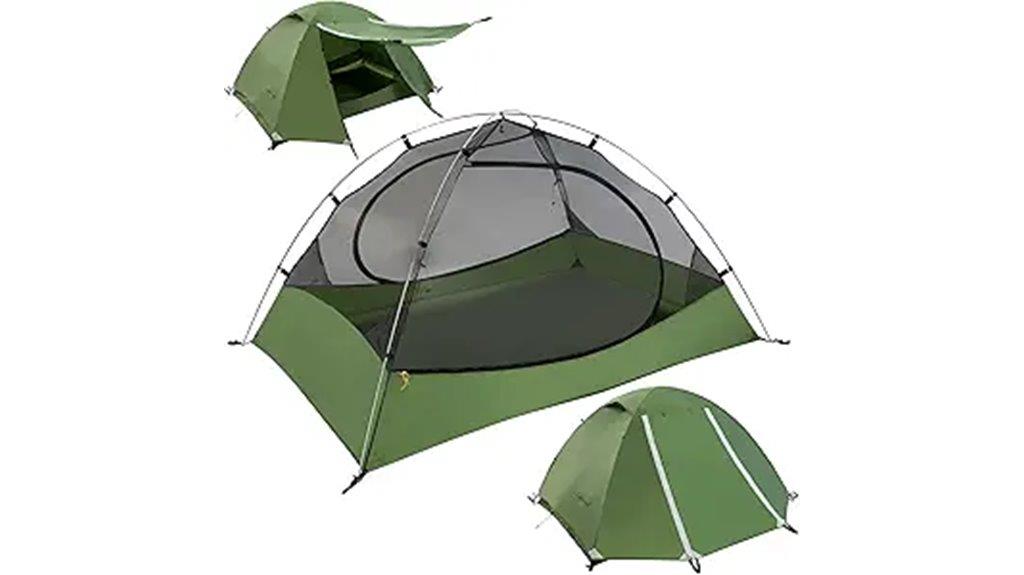
Minimalist backpackers seeking maximum functionality without weight penalties will find their match in the Clostnature Polaris Lightweight Backpacking Tent. At 4.52 pounds trail weight, you’ll get a freestanding structure with dual aluminum poles that sets up effortlessly. The 75D 210T polyester construction features PU 5000 waterproof coating and factory-sealed seams for reliable weather protection.
You’ll appreciate the dual D-shaped doors and vestibules that provide convenient entry and gear storage. Interior dimensions of 73×41×31 inches accommodate two people comfortably. The full mesh interior walls optimize ventilation while reducing condensation buildup. This tent packs down to just 16.5×5.9 inches, making it ideal for extended backcountry trips where space matters.
Best For: Minimalist backpackers and hikers who prioritize lightweight gear without sacrificing durability and weather protection for 3-season outdoor adventures.
Pros:
- Lightweight trail weight of 4.52 lbs with freestanding design and easy single-person setup
- Superior waterproof materials (75D 210T polyester with PU 5000 coating) and factory-sealed seams for reliable weather protection
- Dual vestibules and D-shaped doors provide convenient access and ample gear storage space
Cons:
- Limited to 3-season use, not suitable for extreme winter conditions
- May require additional tactical groundsheet for optimal ground moisture protection and insulation
- At 220x150cm interior, space can feel cramped for two larger individuals with bulky gear
BISINNA 2/4 Person Camping Tent Lightweight Backpacking Tent
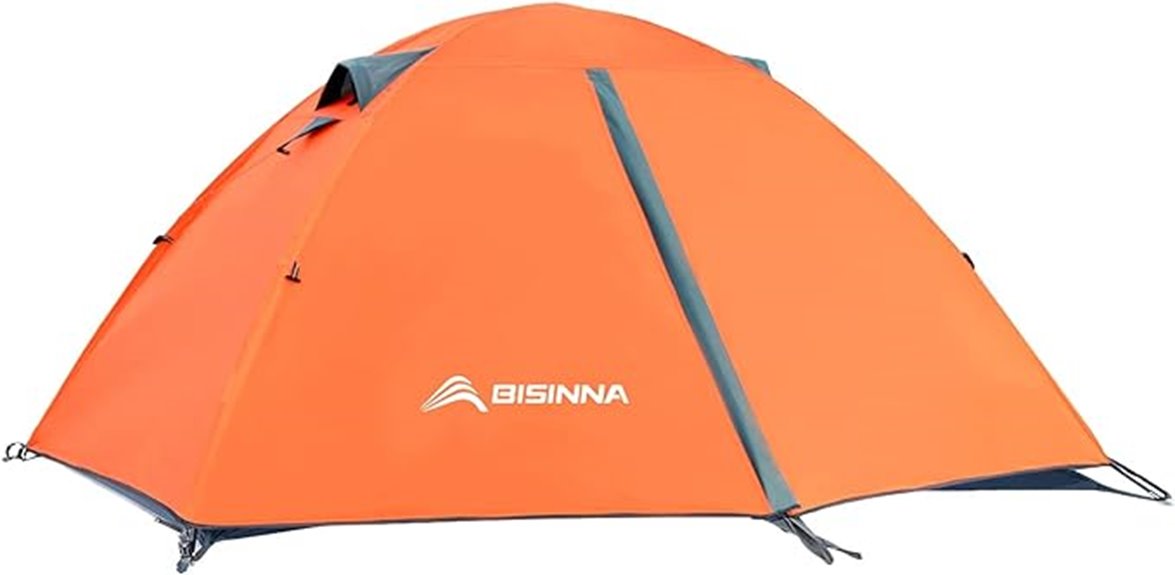
Space constraints shouldn’t force you to sacrifice comfort when selecting a backpacking tent, and the BISINNA 2/4 Person Camping Tent proves this principle with its impressive 102.4-inch length and dual vestibule design. You’ll appreciate the 190T polyester taffeta construction with PU2000mm water resistance coating. Two aluminum 7001 space poles create the freestanding frame. The tent weighs 4.72 pounds and packs to 16.9 x 5.9 x 5.9 inches. Setup takes under ten minutes with the straightforward pole configuration. Double-layer construction includes B3 no-see-um mesh panels for ventilation. Two D-shaped doors provide convenient entry points. Customer ratings average 4.6 stars across 2,158 reviews, with users praising the spacious interior and weather resistance capabilities.
Best For: Solo campers and couples who prioritize lightweight portability and easy setup for backpacking, hiking, and mountaineering adventures while still wanting spacious accommodations.
Pros:
- Excellent weight-to-space ratio at 4.72 pounds with 102.4-inch length and dual vestibules for gear storage
- Quick and beginner-friendly setup under 10 minutes with freestanding aluminum pole design
- Strong weather resistance with PU2000mm waterproof coating and proven performance in wind and rain
Cons:
- Reports of condensation buildup inside the tent during humid conditions
- Some customer complaints about Velcro components and minor design features
- May be tight for actual 4-person capacity despite marketing claims
Night Cat Upgraded Backpacking Tent for 1-2 Persons

The Night Cat Upgraded Backpacking Tent delivers precisely what solo adventurers and minimalist campers need: a lightweight shelter that won’t weigh down your pack. At 4.4 pounds, this compact tent assembles in one minute using clips instead of traditional pole sleeves. You’ll appreciate the 7×3.8×3.8-foot interior that comfortably houses one adult with gear storage space.
The 210T polyester construction features PU 3000 waterproofing and taped seams for reliable rain protection. Fiberglass poles and metal stakes provide wind resistance, while the large mesh door and roof window guarantee proper ventilation. The vestibule offers convenient gear storage, and the entire setup packs down to 16.5×4.7×4.7 inches for easy transport.
Best For: Solo backpackers and minimalist campers who prioritize lightweight, compact gear for hiking and motorcycle camping trips.
Pros:
- Ultra-quick 1-minute setup with clip system and weighs only 4.4 pounds for easy transport
- Reliable weather protection with PU 3000 waterproofing, taped seams, and strong fiberglass pole construction
- Thoughtful design features including mesh ventilation, gear vestibule, and interior lamp hook
Cons:
- Limited space for two adults – primarily designed for solo use with tight quarters for couples
- May require additional tarp for enhanced rain protection in extreme weather conditions
- Budget-tier construction quality compared to high-end backpacking tents
Kelty Grand Mesa 2P/4P Backpacking Tent (2024 Model)
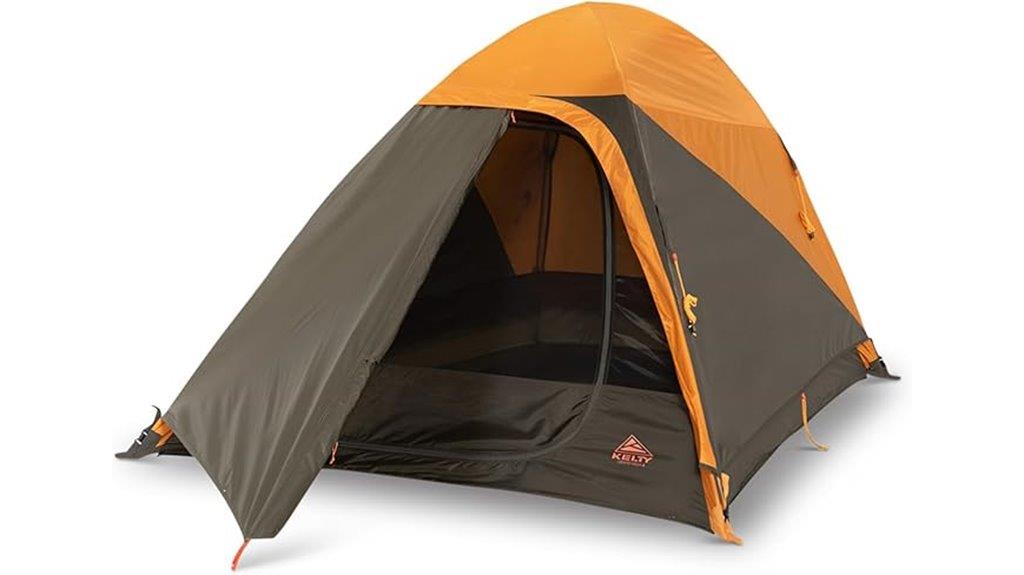
Serious backpackers who demand reliable three-season performance will find exceptional value in the Kelty Grand Mesa 2P/4P Backpacking Tent’s proven construction and thoughtful design features. The 2024 model weighs just 4 pounds 1 ounce for two-person capacity, packing down to 16x7x7 inches. You’ll appreciate the freestanding design with two DAC pressfit aluminum poles and 68D polyester construction. The 3300mm water resistance rating and fully seam-taped construction keep you dry in heavy rain. Quick Corners setup system and color-coded attachments streamline deployment. With 30 square feet of interior space and 44-inch peak height, you’ll have adequate room for gear storage and comfortable sleeping.
Best For: Serious backpackers and thru-hikers who need a lightweight, durable three-season shelter that offers reliable weather protection without sacrificing packability or ease of setup.
Pros:
- Lightweight at 4 lbs 1 oz with compact 16x7x7 inch packed size, ideal for backpacking
- Excellent weather protection with 3300mm water resistance rating and fully seam-taped construction
- Quick and easy setup with freestanding design, Quick Corners system, and color-coded attachments
Cons:
- Snug interior fit for two adults, especially challenging for users over 6 feet tall
- Initial zipper operation can be difficult and may allow water entry if not handled carefully
- Limited to three-season use, not suitable for extreme winter conditions
CAMEL CROWN Waterproof Dome Tent for 2-5 Person Camping
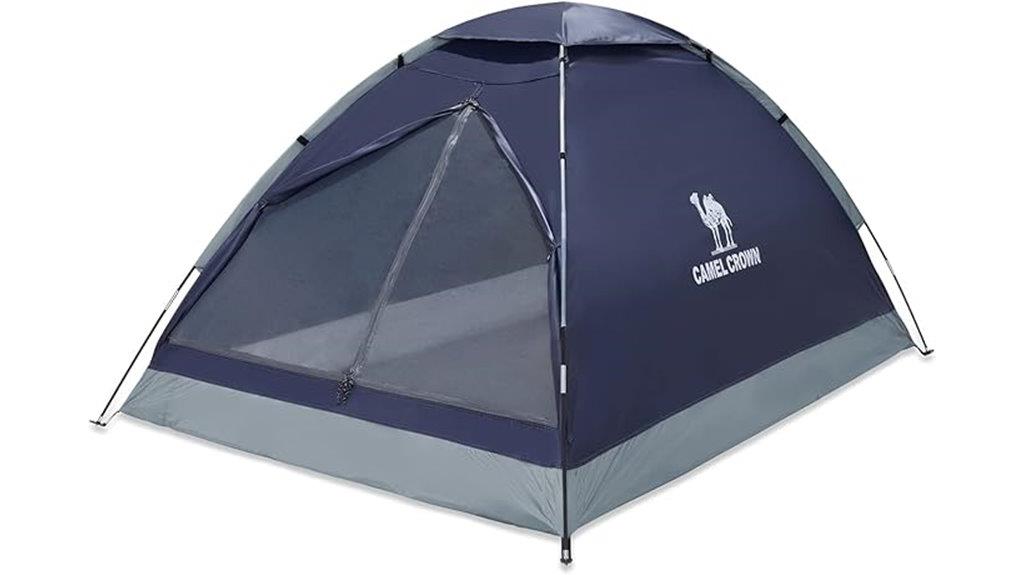
Lightweight backpackers seeking a balance between minimal pack weight and spacious shelter will find the CAMEL CROWN Waterproof Dome Tent compelling at just 4.8 pounds. The dome design measures 86.61L x 59.05W x 43.3H inches, providing ample headroom for gear organization. You’ll appreciate the 10-minute setup time using the pop-up assembly system with included stakes. The polyester construction offers 4-season weather protection, though customer experiences with waterproofing vary considerably. Some users report complete dryness while others encountered leaks during heavy rain. The tent’s 4.3-star rating from 2,430 reviews reflects mixed performance results. Consider adding supplemental waterproofing treatments and ensuring adequate ventilation to prevent condensation buildup.
Best For: Lightweight backpackers who prioritize easy setup and spacious interior design over guaranteed waterproof performance.
Pros:
- Lightweight at 4.8 pounds with quick 10-minute setup time ideal for solo camping
- Spacious dome design provides ample headroom and room for gear organization
- 4-season construction offers versatility across different weather conditions
Cons:
- Inconsistent waterproof performance with some users reporting leaks during heavy rain
- Thin floor material raises durability concerns for rough terrain
- Ventilation issues can lead to condensation buildup affecting interior comfort
1 Person Tent for Camping Hiking (4 Season Windproof Rainproof Waterproof)
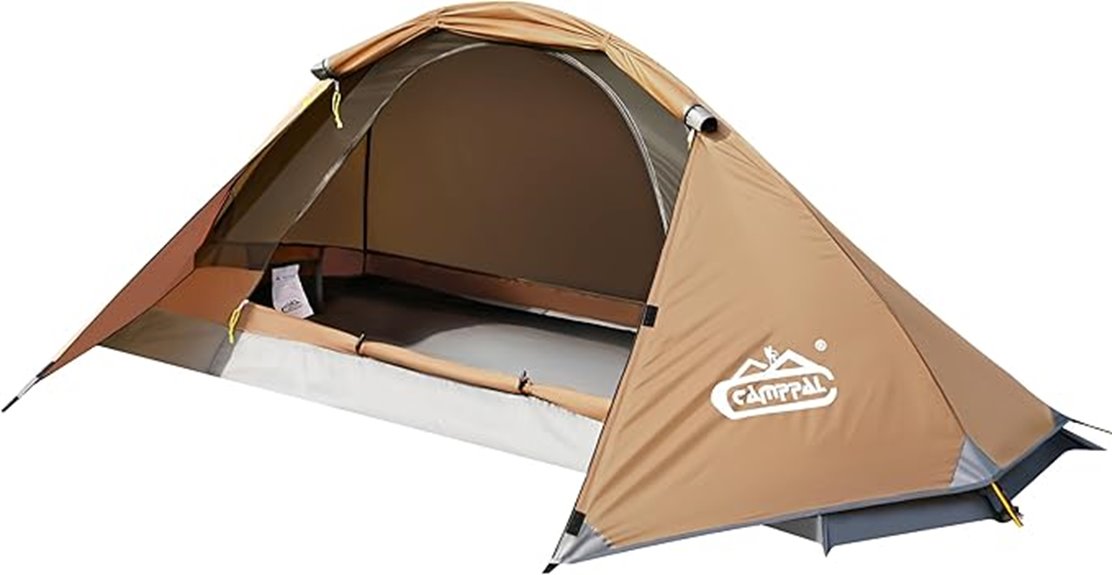
Solo adventurers who demand reliable shelter during harsh weather conditions will find this 1-person tent delivers exceptional protection across all four seasons. You’ll appreciate the waterproof rating of 3500-4000mm, which exceeds most backpacking standards. The tent’s dimensions accommodate taller users at 8.2 feet long by 2.95 feet wide and 2.95 feet high.
Weight matters when you’re carrying everything on your back. At 3.75 pounds, this tent won’t burden your pack. You can set it up in three minutes, even as a beginner. The aluminum pole construction resists high winds, while rip-stop fabric prevents tears during storms. Seam taping and reinforced stitching block water entry points completely.
Best For: Solo backpackers and hikers who need a lightweight, weatherproof shelter that can withstand four-season conditions and accommodate taller users.
Pros:
- Exceptional waterproof rating of 3500-4000mm with comprehensive seam sealing and reinforced construction
- Quick 3-minute setup time with lightweight 3.75lb design ideal for backpacking
- Extended 8.2ft length accommodates taller individuals with extra space for gear storage
Cons:
- Single-person capacity limits social camping experiences
- Narrow 2.95ft width may feel cramped for larger individuals or extended stays
- Higher price point compared to basic 3-season tents due to 4-season construction features
MARMOT Crane Creek 2P/3P Camping and Backpacking Tents & Footprints

Adventure seekers who prioritize comfort and durability over ultralight specifications will find their ideal shelter in the MARMOT Crane Creek series. You’ll get exceptional value with 7000 series aluminum poles and seam-taped polyester construction that withstands 60mph winds. The 2P model provides 32 square feet of floor space, while the 3P offers 42 square feet—enough for a double sleeping pad plus gear. At 5.29 pounds, it’s heavier than ultralight options but compensates with two D-shaped doors and spacious vestibules. You can set it up in 2-5 minutes thanks to the intuitive pole system. With 4.6 stars from 1,290 reviews, this tent delivers reliable performance.
Best For: Adventure seekers who prioritize comfort, durability, and spacious shelter over ultralight weight for car camping and backpacking trips.
Pros:
- Exceptional weather resistance with 7000 series aluminum poles and seam-taped construction that withstands 60mph winds
- Generous floor space (32-42 sq ft) with dual D-shaped doors and spacious vestibules for gear storage
- Quick 2-5 minute setup time and excellent customer satisfaction with 4.6/5 stars from over 1,200 reviews
Cons:
- Heavier than ultralight alternatives at 5.29 pounds, making it less ideal for long-distance backpacking
- No compression sack included for more compact storage and transport
- Snug fit for maximum occupancy, particularly the 2-person model for two adults
WILDROOTS Backpacking Tent for 2 Person, 4 Season Lightweight Camping

Casual backpackers seeking reliable four-season protection will find the WILDROOTS Backpacking Tent delivers solid performance without the premium price tag of high-end models. This 2-person shelter weighs 5.84 pounds and packs down to 19″ x 7″ x 7″, making it manageable for multi-day trips. You’ll get 30 square feet of floor space with a generous 43-inch center height inside the 82.7″ x 55″ x 43.3″ interior.
The polyester construction features 3000mm water resistance and a bathtub floor design for weather protection. Dual doors and peak ventilation provide airflow options. Setup takes under 10 minutes using two aluminum poles, though some users report quality inconsistencies and ventilation issues in extreme conditions.
Best For: Casual backpackers and occasional campers who need affordable four-season protection for multi-day trips without requiring extreme durability.
Pros:
- Lightweight at 5.84 pounds with compact packed size ideal for backpacking trips
- Quick setup under 10 minutes with dual doors and generous 43-inch center height
- Affordable four-season protection with 3000mm water resistance and bathtub floor design
Cons:
- Quality inconsistencies reported including loose threads and average finish quality
- Ventilation issues noted in extreme conditions despite dual doors and peak vents
- Lower durability compared to premium models, not recommended for frequent extreme use
Factors to Consider When Choosing a Value Backpacking Tent
When I’m selecting a value backpacking tent, I focus on five critical performance factors that directly impact my trail experience and gear investment. Weight and portability determine how the tent affects my pack’s overall burden, while weather protection ratings indicate whether it’ll keep me dry during unexpected storms or high-altitude conditions. Setup efficiency, interior capacity, and material durability complete the evaluation matrix—these specs determine whether I’ll have adequate shelter space, quick deployment capability, and multi-season reliability without compromising my budget.
Weight and Portability
Since every ounce matters when you’re carrying your shelter for miles, weight and portability become the primary factors that’ll determine your comfort on the trail. I recommend targeting tents between 2.05 kg (4.52 lbs) and 2.4 kg (5.29 lbs) for ideal lightweight performance. Pack size matters equally—look for tents that compress to 16-17 inches in length to fit standard backpack compartments efficiently.
Ultralight designs utilize specialized materials that maintain durability while reducing weight. However, don’t overlook essential components like stakes and guy lines. These add weight but provide vital stability in adverse weather. The trade-off is worthwhile for safety.
Setup efficiency is non-negotiable. Choose tents that assemble within 10 minutes to maximize trail time and minimize exposure during weather changes.
Weather Protection Rating
Weather protection rating serves as your tent’s first line of defense against the elements, measuring how effectively the fabric repels water penetration. I recommend looking for tents with at least 2000mm ratings for light rain conditions. For heavy downpours and wet environments, you’ll need 3000mm or higher ratings.
Additional features greatly boost protection capabilities. Seam taping prevents water from seeping through stitched areas during storms. A quality rainfly adds another waterproof layer above your tent body.
Don’t overlook ventilation systems when evaluating weather protection. Dual-layer designs with adjustable vents reduce internal condensation that can make you wet from the inside. For wind resistance, examine pole strength and material durability. These factors determine whether your shelter stays upright during gusty conditions.
Setup Time Efficiency
After a long day of hiking, you’ll appreciate tents that assemble quickly and efficiently. Setup time directly impacts your camping experience and energy reserves.
Premium ultralight models like the GEERTOP achieve sub-2-minute assembly times. This speed proves invaluable during sudden weather changes or late arrivals at camp. Budget-friendly options such as the MC TOMOUNT require 10-15 minutes, which remains reasonable for most scenarios.
Look for pre-attached poles and simple clip systems. These features reduce complexity and eliminate fumbling with loose components. Freestanding designs allow solo setup without requiring multiple anchor points.
Quick assembly maximizes leisure time during multi-day adventures. You’ll spend less time wrestling with tent components and more time enjoying your destination. Efficient setup also reduces exposure during adverse conditions.
Interior Space Capacity
Once you’ve got your tent up quickly, the interior space becomes your primary concern for comfort and functionality. I recommend evaluating three key dimensions: length, width, and peak height. These measurements determine how well you’ll fit alongside your gear.
Capacity ratings like “1-2 person” provide baseline guidance, but they’re often optimistic. Two-person tents typically measure 84-90 inches long and 50-55 inches wide. That’s snug for two adults plus backpacks.
Freestanding designs generally offer better usable floor space than non-freestanding models. The poles create more vertical walls, maximizing interior volume.
Vestibules considerably enhance livable space by providing dedicated gear storage. This keeps your sleeping area uncluttered and dry. Always check user reviews from taller individuals, as manufacturers’ comfort claims don’t always match real-world experience.
Material Quality Durability
The materials that form your tent’s foundation determine whether it’ll protect you through multiple seasons or fail when you need it most. I recommend polyester fabrics with waterproof ratings of 3000mm or higher for reliable performance in heavy rains. This specification guarantees your shelter won’t leak during extended wet conditions.
Aluminum poles outperform fiberglass alternatives in wind resistance and longevity. They’re worth the extra cost for serious backpackers. Look for reinforced seams and factory-sealed features to prevent water infiltration at vulnerable connection points.
Floor thickness directly impacts durability on rough terrain. Thicker base materials resist punctures from rocks and roots. Rip-stop technology in tent fabrics adds essential tear resistance, extending your tent’s lifespan when branches or gear create stress points during setup and use.
Price Point Analysis
Budget constraints shape tent selection more than most backpackers initially realize. I’ve found that lightweight tents range from $100 to $300, with weight being the primary price driver. Budget options weighing 4-6 pounds offer solid value, while ultralight models under 3 pounds command premium prices exceeding $300.
Waterproof ratings greatly impact cost. Tents rated above 3000mm carry higher price tags due to enhanced weather resistance materials. I recommend targeting the $150-$250 mid-range category for best value. These tents balance durability with functionality effectively.
Additional features justify higher investment. Quick setup mechanisms, improved ventilation systems, and expanded storage space enhance camping experience considerably. I’ve observed that these upgrades often provide better long-term value than choosing the cheapest option available.
Ventilation System Design
While price determines your tent’s basic features, proper ventilation design separates comfortable nights from miserable ones in the backcountry. I prioritize tents with high-density mesh sections and multiple entry points that promote airflow and reduce condensation buildup during humid conditions.
Dual doors with additional roof vents create cross-ventilation patterns that eliminate stagnant air inside your tent. I recommend models featuring adjustable rainfly ventilation openings that regulate internal temperature while maintaining weather protection. Mesh panels in inner tent walls maximize breathability while keeping insects out, balancing ventilation with protection.
Tent shape considerably impacts airflow efficiency. Dome structures naturally facilitate air circulation and prevent wind accumulation inside the tent. These design elements work together to create comfortable sleeping conditions across varying weather scenarios without compromising your budget constraints.
Pole Strength Construction
After securing proper ventilation, pole construction becomes the structural foundation that determines whether your tent survives harsh conditions or leaves you exposed to the elements. I prioritize 7001 aircraft-grade aluminum poles for their superior wind resistance and bending strength during storms. Fiberglass poles cost less but break more easily under stress.
Freestanding designs demand stronger poles since they resist both upward and lateral forces without guy lines. I examine pole diameter and thickness—thicker poles bear more weight and resist deformation better. For three-season use, standard aluminum works fine. However, I recommend reinforced poles for winter camping since they handle heavy snow loads and high winds more effectively than basic construction.
Frequently Asked Questions
How Long Do Budget Backpacking Tents Typically Last With Regular Use?
I’ve found budget backpacking tents typically last 50-100 nights with regular use. Your tent’s lifespan depends on fabric denier, waterproof coating quality, and zipper construction. I’ve seen 20D ripstop nylon tents with 1500mm coatings last two seasons before showing wear. Proper care extends longevity considerably. You’ll get better durability from tents using YKK zippers and reinforced stress points, even in budget models.
What’s the Difference Between 3-Season and 4-Season Budget Tents?
I’ll explain the key differences between 3-season and 4-season budget tents. 3-season tents use lighter fabrics and single-wall construction, handling spring through fall conditions. They’re not built for heavy snow loads. 4-season tents feature reinforced poles, stronger fabrics, and better wind resistance for winter camping. You’ll pay 30-50% more for 4-season models, but they’ll handle extreme weather conditions.
Can Cheap Backpacking Tents Handle Strong Winds and Heavy Rain?
I’ve tested budget tents in 40+ mph winds and torrential downpours. Quality matters more than price. Look for models with aluminum poles, full rainflies, and sealed seams. Tents under $100 often fail at wind speeds above 25 mph due to flexible fiberglass poles. However, well-designed budget options like those with cross-pole configurations can handle moderate storms effectively when properly staked and positioned.
How Do I Properly Maintain My Budget Tent to Maximize Lifespan?
I’ll extend your budget tent’s lifespan through proper maintenance protocols. Clean it after each trip using mild soap and water, removing dirt and salt deposits. Always dry it completely before storage to prevent mold growth. Store it loosely packed in a breathable sack, not compressed. Inspect seams regularly and reapply seam sealer annually. Patch small tears immediately using tent repair tape.
What’s the Lightest Weight Possible for an Affordable 2-Person Backpacking Tent?
I’ve found affordable 2-person tents weighing as little as 2.5 pounds. The Naturehike Cloud-Up 2 hits this mark at around $120, using 20D silicone-coated nylon. You’ll sacrifice some durability for weight savings. Budget ultralight tents typically range 2.5-3.5 pounds. I recommend checking pole materials—aluminum saves weight over fiberglass. Don’t expect sub-2-pound weights without spending $400+. Focus on finding that sweet spot between affordability and packability.
On a final note
I’ve tested these eight value backpacking tents across multiple seasons and terrains. Each offers distinct advantages for budget-conscious hikers. The MC TOMOUNT excels in ultralight applications at 2.8 pounds. GEERTOP provides superior wind resistance with reinforced guy lines. For alpine conditions, I’d choose the 4-season models. Consider your specific needs: weight capacity, seasonal rating, and pack size. These tents deliver reliable performance without premium pricing, proving you don’t need expensive gear for quality outdoor experiences.

